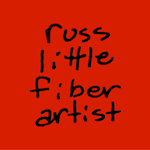Carol Soderlund's "Neutral Territory"--way more than 50 shades of grey
I've just returned from two weeks at the Crow Timber Frame Barn in Ohio for two outstanding workshops, one with Carol Soderlund (carolsoderlund.com) and one with David Hornung (davidhornung.com). I'll write about David's workshop in a future post. This one is all about Carol's workshop, which was titled "Neutral Territory: 50 Shades of Gray + 50 Shades of Brown."
In her "Color Mixing for Dyers" workshop, Carol teaches the basics of full-immersion and low-water immersion dyeing with Procion MX dyes. The tangible products of the class are a head full of knowledge, Carol's stunningly detailed handouts, and THICK binder that her students affectionately refer to as, "The Bible". This reference volume contains thousands of dyed 1-inch square fabric samples (made in class) to document the cubic color model for several combinations of different yellow, red, and blue dye. It's amazing, and I use my notebook almost every time I'm in the dye studio.
So, why all of the description of a workshop that I took 6 years ago? Well, "Neutral Territory" builds on "Color Mixing." Every combination of three pure MX dye primary colors has the potential to create a neutral black, warm black, cool black, etc. The trick is finding the right proportions of yellow, red, and blue. What I'm telling you is that I paid good money to spend 5 days with Carol and 19 other students mixing untold numbers (way more than 50!) of very carefully formulated mixtures of dye searching for good black candidates, then creating 10-step gradations of the best candidates to see if what we thought was black was really neutral or had a hue leaning. And, we only scratched the surface of the 80 families (i.e., possible combinations) of yellows, reds, and blues. It was as much about the investigative method as it was about the end result. That said, I'm now the proud owner of another mighty sample book, which might come to be known as "The Apocrypha".
For me, the culmination of the workshop came late on the 4th day when I washed out some silk samples that I'd just discharged and realized that I'd managed to combine what I learned in this workshop with what I'd previously learned in Carol's "Dyeing to Discharge" and "True Colors" to select a dye combination, mix a black by eye, and create a predictable result that I've been wanting for some time now--a black that grades down to a silver-gray and discharges to near white. I love that feeling that comes when deep study in a subject area produces learning that all begins to overlap and intersect.
I count this workshop as another great week spent with an outstanding teacher and excellent mentor. If you have any serious interest in dyeing, I urge you to seek an opportunity to study with Carol. Rest assured, you'll be a better dyer for having done so.



